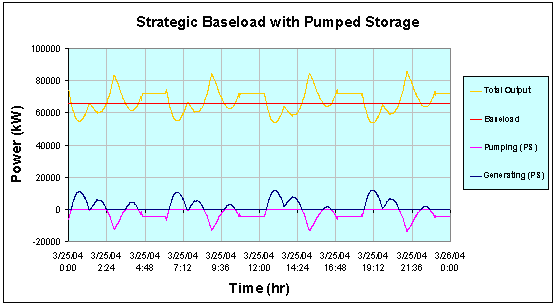


| Pumped Storage Use |
Reasons for storage Storage operation Storage source References
Reasons for storage
The geographical spread of the sites and the shape of the power profiles made it difficult to attain an approximate straight line baseload. This was further compounded by the variations in tidal speeds during spring and neap tides. Pumped storage was therefore employed to level off the daily peaks and troughs.
back to top
Storage operation
The basic concept is to store the energy when the varying power output is above the baseload and then discharge this energy when the varying output falls below the baseload. The baseload was chosen such that the daily energy required for discharge (generating) was 70 % of that required for storage (pumping) thereby accounting for losses. This was achieved by the help of the Excel Worksheet which compares the areas (amount of energy) above and below a given baseload. The graph below shows the pumping and generating curves required to attain a straight line baseload for mean tidal speed. The curve variations during spring and neap tides were also determined.

back to top
Storage source
Scottish Power’s 400MW Pumped Storage Hydro plant at Ben Cruachan was selected for this situation. The plant houses four generator/motor sets and when the turbines are on "spinning reserve" it can supply 200 MW of electricity to the grid in less than 30 seconds and a further 200 MW within two minutes. Cruachan is capable of operating continuously for up to 22 hours when the reservoir is filled to capacity. Currently it runs for periods of two or three hours at a time to meet daytime peaks.
For more details please refer to the storage page of the technology section.
The percentage of Cruachan’s capacity used, as well as the percentage energy lost using storage have all been calculated for the various scenarios.
back to top
References
- Storage at Cruachan from Scottish Power at:
http://www.scottishpower.com